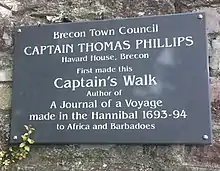Hannibal (slave ship)
The Hannibal was an English slaver (slave ship) of the Atlantic slave trade. The wooden sailing ship was 450 tons and mounted thirty-six guns, which it was frequently forced to use; seven hundred people could be forced into its hold at one time. Many slavers rigged shelves in the middle called a "slave deck," so that individuals could not even sit upright during the entire voyage. The owners of the ship were paid 10.50 for every slave, but only for those brought to the "New World" alive. As a result, the slaves were fed regularly twice a day a meal of corn meal and beans, given a litre of water per day, and given exercise for an hour every evening to keep them fit. Despite these efforts, an average 47% of the slaves died from disease, physical injuries, or suicide on the Hannibal's voyages.
The ship is most remembered for its disastrous voyage of 1694. Captain Thomas Phillips commanded the Hannibal. He was a British captain and a member of the Royal African Company. To prevent the slaves from running away he was advised to cut off the arms and legs of some to terrify the rest as was the practice of many other slave ship captains, but he refused to do something so drastic.
Phillips, at the age of 29 years and on his second voyage, became the captain of the infamous slave ship the Hannibal. Under his command he was directly responsible for the tragic deaths of 328 (47 per cent) of the 700 enslaved African women, men and children on board, along with 18 of his crew of 70. A very large number of people died in the cruellest of ways.
The voyage of 1694
This voyage began as any other slave trade in 1694. The ship arrived in Ouidah, an African port located in modern-day Benin, and purchased 692 slaves, about one-third of them women.
Upon boarding the ship the slaves were handcuffed to one another in pairs by their wrists and legs, and branded with a capital "H" to claim them for the Hannibal.
The ship reached the New World with only 372 slaves remaining. Three hundred and twenty slaves died or were dumped overboard by the crew during the voyage. It is postulated that some slaves may have been thrown overboard so that their insurance value could be collected, but it appears the largest killer was an outbreak of dysentery. Others may have jumped overboard out of fear.
Phillips is reputed as stating that twelve slaves "willfully drowned themselves" during the trip and that several others persistently refused food starving themselves to death, "for it is their Belief that when they die they return to their own Country and Friends again."
Phillips was deeply involved in the slave trade, in which he had hoped to make a great deal of personal wealth by selling his human cargo. Phillips persisted in the slaving voyages despite his growing personal distaste for slavery. In his book published after the voyage he recalled:[1]
I have been inform’d that some commanders have cut off the legs or arms of the most wilful, to terrify the rest, for they believe if they lose a member, they cannot return home again: I was advis’d by some of my officers to do the same, but I could not be perswaded to entertain the least thoughts of it, much less to put in practice such barbarity and cruelty to poor creatures, who, excepting their want of christianity and true religion, (their misfortune more than fault) are as much the works of God’s hands, and no doubt as dear to him as our selves; nor can I imagine why they should be despis’d for their colour, being what they cannot help, and the effect of the climate it has pleas’d God to appoint them. I can’t think there is any intrinsick value in one colour more than another, nor that white is better than black, only we think it so because we are so, and are prone to judge favourably in our own case, as well as the blacks, who in odium of the colour, say, the devil is white, and so paint him.
The diseases which killed so many slaves during the voyage also affected Phillips, leaving him permanently deaf, which caused him to retire to Wales, after which he never sailed again.[1]
A controversial plaque was erected during 2006 in the town of Brecon, Wales, along Captains Walk. The plaque is to memorialise the life of Captain Thomas Phillips, slave trader.

External links
- Intro To Afro-American Studies
- Slave Ships
- The Slave Trade On Shore
- Hannibal Diary
- Should society memorialise a Slave Trader?
- A Journal of a Voyage Made in the Hannibal of London, Ann. 1693, 1694, From England, to Cape's Monseradoe, in Africa, And thence along the Coast of Guiney to Whidaw, the Island of St. Thomas, An so forward to Barbadoes
References
- Phillips, Thomas (1732). A Journal of a Voyage Made in the Hannibal of London, Ann. 1693, 1694, From England, to Cape's Monseradoe, in Africa, And thence along the Coast of Guiney to Whidaw, the Island of St. Thomas, An so forward to Barbadoes: With a Cursory Account of the County, the People, their Manners, Forts, Trade, &c. London: Walthoe. p. 219. Retrieved 24 January 2020.
- The Earth and its Peoples: A Global History by Richard Bulliet, Pamela Crossley, Daniel Headrick, Steven Hirsch, Lyman Johnson, and David Northrup, published by the Houghton Mifflin Company, 2005, ISBN 0-618-42770-8
The Trans-Atlantic Slave Data Base. https://web.archive.org/web/20161211184555/http://www.slavevoyages.org/assessment/essays
'Nautical Women. Women sailors and the women of Sailortowns. A forgotten diaspora c.1693-1902'. By Rosemary L Caldicott. Bristol. Radical Pamphleteer #43. Published by Bristol Radical History Group, 2019. ISBN 978-1-911522-46-1